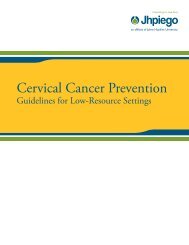Manual for Male Circumcision under Local Anaesthesia
Manual for Male Circumcision under Local Anaesthesia
Manual for Male Circumcision under Local Anaesthesia
You also want an ePaper? Increase the reach of your titles
YUMPU automatically turns print PDFs into web optimized ePapers that Google loves.
<strong>Male</strong> circumcision <strong>under</strong> local anaesthesia<br />
Version 3.1 (Dec09)<br />
Focusing<br />
Clients are often overwhelmed by emotional or personal problems<br />
related to their particular sexual and reproductive health problems.<br />
They may want to address all the issues at once. If clients start to talk<br />
about problems or situations that will be discussed later in the session,<br />
the counsellor may want to bring the topic of discussion back to the<br />
current issue.<br />
Example:<br />
At the beginning of the first counselling session, the client begins<br />
talking about the most recent situation when he may have been<br />
exposed to HIV. He asks about where and how he can get<br />
condoms.<br />
The counsellor does not want to interrupt the flow of the<br />
discussion, so says: “Using condoms is an excellent way to reduce<br />
your risk of getting an STI or HIV infection. We can talk about that<br />
in a few minutes. Right now, let’s continue talking about your HIV<br />
situation.”<br />
If the client wants to talk about other emotional or personal issues,<br />
such as problems at home or a partner’s drug use problem, the<br />
counsellor should help the client find appropriate support.<br />
Affirming<br />
Affirming is congratulating or complimenting clients on the positive<br />
actions that they have taken. It is important to encourage success.<br />
Complimenting clients helps them feel respected and valued and<br />
encourages them to try to make other changes to reduce their risk of<br />
HIV infection. It may also make them more willing to share in<strong>for</strong>mation<br />
about other actions they have taken.<br />
Example:<br />
Client: “I’ve recently started using condoms each time I have sex”.<br />
Counsellor: “That’s a really positive step in protecting yourself<br />
against HIV and sexually transmitted infections. Well done!”<br />
Clarifying<br />
Counsellors clarify in order to make sure that they <strong>under</strong>stand a<br />
client’s statements or questions. Clarifying also helps the client<br />
<strong>under</strong>stand his own situation or feelings better and identify uncertainty<br />
or conflict between his thoughts and behaviour.<br />
Educating and Counselling Clients and Obtaining In<strong>for</strong>med Consent Chapter 3-8
















